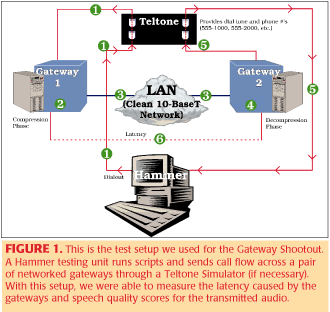














|


INTRODUCTION
As Internet
telephony gateways evolve from a fringe technology to a mainstream tool,
their developers face the challenges of integration, reliability, audio
quality, and gatekeeper functions. Covering the trend, TMC Labs is shifting
its gateway testing methods from qualitative and stand-alone testing to
quantitative and comparison testing. We will test T1 and fax options of
gateways in the future, but Part I of our shootout is dedicated to the
analog voice functionality of gateways from Linkon, Inter-Tel, and Nuera,
based on a Sun platform, a PC, and a black box, respectively. We also chose
these gateways based on their installation process, documentation, support,
competitive pricing, and mainstream availability. Equipment we used included
the Hammer IT 2.1.3 software and the Hammer VoIP 2.0.2 test suite, plus
a TLS-4 analog line simulator from the Teltone Corporation. You can visit
the Web sites of these companies at www.ham.com and www.teltone.com,
respectively.
TOOLS &
METHODOLOGY
The most important
aspect of this equipment was Hammer's VoIP suite. Earlier versions of the
Hammer IT VoIP suite included Perceptual Speech Quality Measurements, but
version 2.0x is the first version to include testing for speech latency.
Midway through our tests, Hammer provided us with an even newer revision
because Hammer's disconnect tone conflicted with Linkon's handshake tone.
This conflict is explained below in the Operational Testing section.
An important
part of the prompt test is measuring latency. This works by listening for
DTMF tones that have been played and time-stamped at the originating Hammer
channel. These tones travel to the local gateway, where they are compressed,
packetized, and sent across the network. At the remote gateway, the packets
are reassembled, decompressed, and sent to the terminating Hammer channel,
where they are time-stamped again. The difference between time stamps equals
the latency. As shown in Figure 1, this path consists of an analog line
connection (1) stemming from one channel on the Hammer to the first gateway,
a compression phase (2) at the gateway, a network connection (3) to another
gateway where the speech undergoes a decompression phase (4), and finally,
another analog connection (5) from the second gateway to a terminating
channel (final destination phone number) on the Hammer unit. This provided
us with five distinct phases that all speech would travel across: Two analog
line connections, a compression and decompression phase, and a network
path connecting the two gateways.
Our goal was
to examine only the latency introduced by the gateways because of compression
and decompression algorithms, so we had to minimize the latency effect
of the analog and network connections (phases 1, 3, and 5). Better gateways
don't just compress and decompress the voice, they do it as quickly as
possible to minimize any latency introduced.
 The
IP network between the two gateways was easy to manage because we used
a "clean" network with a 10-BaseT hub connected only to a PC running Gatekeeper
and network management software. Meanwhile, the analog circuit between
each gateway and the Hammer channels depended on whether the gateway being
tested used FXS ports, which provide their own dial tone, or FXO ports,
which need dial tone provided to them. Only the Nuera gateway used FXS
ports, so we connected it directly to the Hammer system. The Inter-Tel
and Linkon gateways used FXO ports, so we used the Teltone simulator between
the Hammer and the gateways to generate dial tone. For these two gateways,
we also subtracted the Teltone-induced latency (12 milliseconds for each
half of the Hammer-to-gateway circuit) from the final figures. The
IP network between the two gateways was easy to manage because we used
a "clean" network with a 10-BaseT hub connected only to a PC running Gatekeeper
and network management software. Meanwhile, the analog circuit between
each gateway and the Hammer channels depended on whether the gateway being
tested used FXS ports, which provide their own dial tone, or FXO ports,
which need dial tone provided to them. Only the Nuera gateway used FXS
ports, so we connected it directly to the Hammer system. The Inter-Tel
and Linkon gateways used FXO ports, so we used the Teltone simulator between
the Hammer and the gateways to generate dial tone. For these two gateways,
we also subtracted the Teltone-induced latency (12 milliseconds for each
half of the Hammer-to-gateway circuit) from the final figures.
Another important
component of the prompt test is the PSQM score, which determines the quality
of speech according to the benchmark assessment of a group of human judges
endorsed by the International Telecommunications Union (the ITU-T P.800
and P.861 standards). Visit the ITU's Web site at www.itu.org. The algorithm
plays sound clips chosen for the range of sounds that they produce, not
for the clips' actual meaning, which tend to have an eerie and nonsensical
nature. (Examples include "I worship wooden idols ... I want a minute with
the inspector;" "You will have to be very quiet ... There is nothing more
to be seen;" and a nasal man's voice drawling over the word "hello.") Each
of the sentences is read in a male, female, and child's voice, encompassing
a range of tones. Like the DTMF tones in the latency test, the sound clips
are compressed, packetized, sent across the network, and decompressed by
the remote gateway, which plays the clip back to the Hammer. The Hammer
then takes this signal and passes it to the PSQM algorithm along with the
original prompt from the voice library. The PSQM algorithm compares the
received prompt to the original one and reports a PSQM score.
To complete
our testing procedure, we configured the prompt test to produce 100 test
calls with sufficient time between calls for each gateway to disconnect
and reset itself for the next call. We found that 50 calls per hour provided
an adequate time-out between calls (Figure 2). We performed the prompt
test four times on each set of gateways: once for latency testing and once
for PSQM scores, using two compression schemes. Finally, we also ran the
PSQM test on the Teltone unit, but the results of this test are for comparison
purposes only. As Hammer engineers explained to us, the PSQM scores are
non-linear and are attained using complex algorithms. Trying to "subtract"
the Teltone's PSQM scores from a gateway's actual scores would not give
an accurate figure.
Reprinted by
Reprint Services with permission from TMC. For reorders call Reprint Services
at 651-582-3800. For subscription information call TMC at 203-852-6800
or subscribe FREE online at www.internettelephony.com. 986773
|



